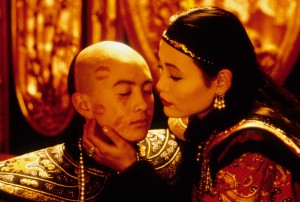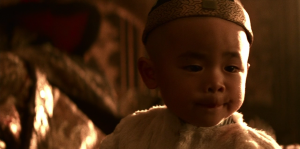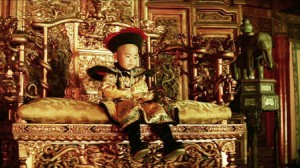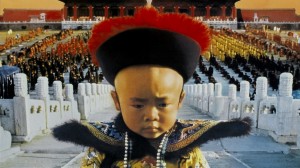Though boasting stunning cinematography from ace Italian lenser Vittorio Storaro, who shot the film in the Forbidden City, the movie suffers from an overly episodic narrative, no coherent story, and no epic hero at its center.
Some of the film’s flaws are determined by the historical facts. The protagonist, Pu Yi, who became emperor of China at the age of three, was a passive man who lacked any power over his life. He’s more of a vessel of–and reactor to–the radically changing political circumstances, which at the end find him as a gardener.
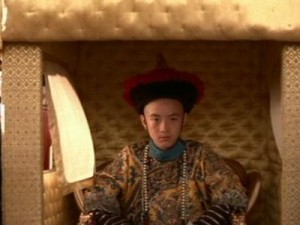 When the revolution occurs, Pu Yi is driven from the Forbidden City, and spends his 20s as a jazz-age playboy. Then the Japanese invade Manchuria (in 1932), and he agrees to serve as the puppet emperor of Manchukuo. After the War and the Communist Revolution, he is imprisoned. He spends his last years as a gardener of Beijing’s botanical gardens! At peak form, Bertolucci makes a case that it’s possible to make an epic movie without an epic hero, given the superlative technical qualities of the film, marked by attention to the smallest detail of costume design.
When the revolution occurs, Pu Yi is driven from the Forbidden City, and spends his 20s as a jazz-age playboy. Then the Japanese invade Manchuria (in 1932), and he agrees to serve as the puppet emperor of Manchukuo. After the War and the Communist Revolution, he is imprisoned. He spends his last years as a gardener of Beijing’s botanical gardens! At peak form, Bertolucci makes a case that it’s possible to make an epic movie without an epic hero, given the superlative technical qualities of the film, marked by attention to the smallest detail of costume design.
Lack of strong, distinguishable roles may have accounted for the fact that none of the performers was nominated, though John Chen gives an impressive performance in a challenging role. Nonetheless, in terms of visual images, art direction, costumes, and editing, “The Last Emperor” offers a consistently exciting treat to the eyes–sheer visual pleasure. Here is a movie that MUST be seen on the big screen.
In an uncharacteristically modest and understated performance, Peter O’Toole shows up as the emperor’s Scottish tutor, who’s brought to introduce him to Western culture and mores.
Bertolucci’s Oscar win, at his second nomination (the first was for Last Tango in Paris), made him the first and only Italian filmmaker to receive a competitive Oscar, albeit for an English-speaking picture. Despite multiple nominations, Fellini had never won a legit Oscar, just an honorary one, but some of his movies won the Best Foreign-Language Oscar.
Narrative Structure: Flashbacks and Flashforwards
The tale begins in 1950, when Puyi arrives at Fushun Prison as a political prisoner and war criminal, having been captured by the Red Army of the Soviet Union in 1945; he was in their custody for five years. Puyi attempts suicide, and becomes unconscious.
In a flashback, Puyi relives how he was summoned to the Forbidden City in 1908, at age two, by the dying Emperess Dowager Cixi (Lisa Lu). Cixi announces that Puyi will be the new emperor. After his coronation, Puyi wishes to go home, which is denied him.
Despite having many helpers to wait on him, his only real friend is his nurse, who accompanied him and his father to the palace on Empress Dowager’s summons.
In a series of chronological flashbacks, we observe Puyi’s early life: from his imperial upbringing in the Forbidden City with his younger brother, Pujie, during the Chinese Republic, his tutelage under a Scotsman named Reginald Johnston (Peter O’Toole) and his marriage to Wanrong (Joan Chen), his subsequent exile, his puppet-like reign of Manchuko, and capture by the Soviet Army—all of which are intermixed with flash-forwards portraying him in prison life.
Under the “Communist re-education program” for political prisoners, Puyi is coerced to renounce his forced collaboration with the Imperial Japanese invaders for war crimes during their occupation of China. After a discussion with the camp commandant and upon watching a film about the Japanese wartime atrocities, Puyi recants his stance and is rehabilitated by the government in 1958.
The film ends with a flash-forward to the mid-1960s during Mao’s Cultural Revolution. Puyi is now a gardener, living a simple life. On his way home from work, he encounters a Red Guard parade, with children playing music and dancers. His prison camp commander, his only friend at the time, is forced to wear a dunce cap and a board bearing punitive slogans. He is one of the political prisoners punished as an anti-revolutionary.
Puyi later visits the Forbidden City as a tourist, where he meets a little boy wearing a red scarf of the Pioneer Movement. The young Communist orders Puyi to step away from the throne. However, Puyi proves that he was the Son of Heaven. Puyi finds a 60 year-old pet cricket given to him by an elderly Mandarin on his coronation day. He gives it to the boy, who is amazed by the gift.
The film ends with a guide leading a tour in front of the throne, where the sums up Puyi’s life in a few brief sentences, including his death in 1967.
Cast
Aisin -gioro “Henry” Pu Yi (John Lone)
Wan Jung/Elizabeth (Joan Chen)
Reginald Johnston (Peter O’Toole)
The Governor (Ying Ruocheng)
Chen Pao Shen (Victor Wong)
Big Li (Dennis Dun)
Masahiko Amakasu (Ryuichi Sakamoto)
Eastern Jewel (Maggie Han)
Interogator (Ric Young)
Wu Jun Mei (Wen Hsiu)
| The Last Emperor | |
|---|---|

Theatrical release poster
|
|
Credits:
Directed by Bernardo Bertolucci
Screenplay by Mark Peploe, Bertolucci, based on From Emperor to Citizen: The Autobiography of Aisin-Gioro Puyi by Puyi
Produced by Jeremy Thomas
Cinematography Vittorio Storaro
Edited by Gabriella Cristiani
Music by Ryuichi Sakamoto; David Byrne; Cong Su
Production companies: Hemdale Film Corporation; Recorded Picture Company
Distributed by Columbia Pictures
Release dates: October 4, 1987 (Tokyo); October 23, 1987 (Italy); February 26, 1988 (UK)
Running time: 163 minutes
Budget $23.8 million
Box office $79 million

